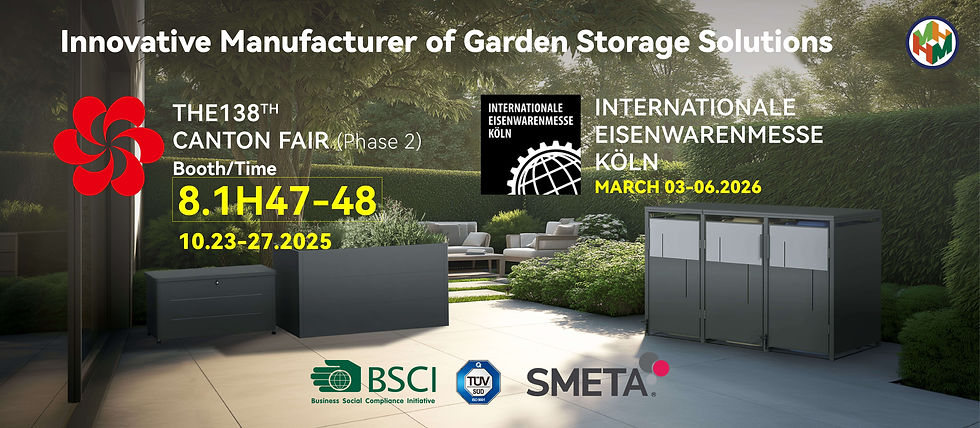Why Rust Prevention is an Investment, Not an Expense: A Guide for European Procurement Managers
- Catrina

- Sep 8
- 4 min read
Updated: Sep 9
Consumers don’t just want durability; they expect it. Rust is the silent killer of user satisfaction. Here’s how smart design prevents it—and builds loyalty that lasts.
I’ve spent the past two decades helping European retailers and e-commerce brands solve one recurring headache: outdoor product returns due to rust. It’s a subtle problem until it isn’t. The moment rust appears, your customer trust vanishes. It’s no longer about the product itself—it becomes a judgment on your entire brand.

At Hongmao Garden, we realised that if we wanted to make products that last, we couldn’t follow industry norms. We had to exceed them. That meant obsessing over every detail—from the sheet metal base to the powder on the surface to the welds between them. But this article isn’t about us. It’s about you—whether you’re a procurement manager, a product developer, or a brand trying to reduce return rates.
I’m going to walk you through:
What drives consumers to care so deeply about rust prevention
The product design decisions that make rust nearly impossible
How environmental concerns tie into rust-resistance
What tests truly matter when evaluating a factory’s durability claims
This isn’t just an education. It’s your rust-free roadmap.
Table of Contents
Why is rust such a dealbreaker for end consumers?
Rust doesn’t just affect products. It affects perception.
When a customer buys an outdoor product—a parcel box, a raised bed, a mailbox—they’re trusting that it will stand strong through storms, frost, and time. Rust tells them otherwise.
Once it appears, rust does three things:
Signals cheapness: Even a durable product feels low-end when rust spots emerge
Destroys confidence: Consumers feel misled and betrayed by marketing claims
Drives vocal frustration: Rust complaints frequently become 1-star reviews

Rust issues disproportionately affect e-commerce platforms like Amazon and Otto, where customers can instantly post negative reviews. These comments don’t just hurt product pages—they derail search rankings and brand reputation.
What consumers actually expect
Visual longevity: No discolouration or bubbling after 12+ months
Functional durability: Hinges, lids, locks must not seize or snap
True weather resistance: Rain, snow, salt spray should not weaken the structure
Retailers and brands often underestimate this expectation gap. If you aim to serve the German or Dutch markets, where consumers are particularly critical and weather is harsh, rust-resistance must be designed in—not treated as an afterthought.

What design features actually prevent rust in outdoor products?
Rust-resistance isn’t marketing. It’s engineering.
Let’s look at the five most effective design interventions:
1. Hot-Dip Galvanisation
This is the baseline for structural protection. Unlike cold-galvanised materials, hot-dip zinc coats every edge—including cut seams and welds. With a film thickness of 80–90μm, it provides full-circle protection.
2. Powder Coating with AkzoNobel Paint
REACH-compliant and globally trusted, AkzoNobel’s polyester powder ensures:
UV resistance
Chemical resistance
Excellent colour retention
We use a total membrane thickness (galvanised base + powder) that exceeds 119μm.

3. 304 Stainless Steel Hardware
Bolts, hinges, brackets—these often fail first. That’s why our screws and nuts are all 304 stainless steel, passing 120H+ salt spray tests.
4. Full Welding on Key Points
Spot welding leaves gaps. Full welding seals moisture-prone areas like door sills and lid corners.
5. Thoughtful Structural Drainage
We engineer drainage holes in places you might not notice, preventing hidden water accumulation that leads to corrosion.
How can preventing rust help the environment?
Rust = waste. Prevention = sustainability.
When a product fails due to corrosion, the entire lifecycle shortens. That means:
Increased material waste
More frequent replacements
Higher emissions per unit of utility
In contrast, anti-rust design offers:
Longer usage lifecycle (5–10 years)
Less packaging waste
Reduced logistics footprint
Lower return rates = fewer reverse shipments

Durability is sustainability. European buyers know this—it’s embedded in eco-conscious purchasing behaviour.
Are rust-proof products more expensive in the long run?
The upfront cost might be higher. But the total cost? Much lower.
Think about the costs of:
Handling returns
Replacing faulty units
Damage to brand reputation
Lost future sales
When you invest in rust-proof design, you mitigate all of these.
Let’s do some rough numbers:

Savings: €6.12 per unit. Multiplied by 10,000 units? Over €60,000.
What testing standards truly prove rust resistance?
A pretty finish is easy. Passing the test? That’s what matters.
We insist on third-party testing and full reporting for every major standard:

Only when products meet or exceed these benchmarks do we approve them for production.
Conclusion
Rust isn’t a cosmetic issue. It’s a business risk, a brand hazard, and a sustainability threat. But it doesn’t have to be. With the right combination of galvanisation, coating, hardware, structure, and testing, rust can be nearly eliminated.
And that means fewer returns. More positive reviews. And longer-lasting customer loyalty.
CEO of Hongmao Garden







Comments